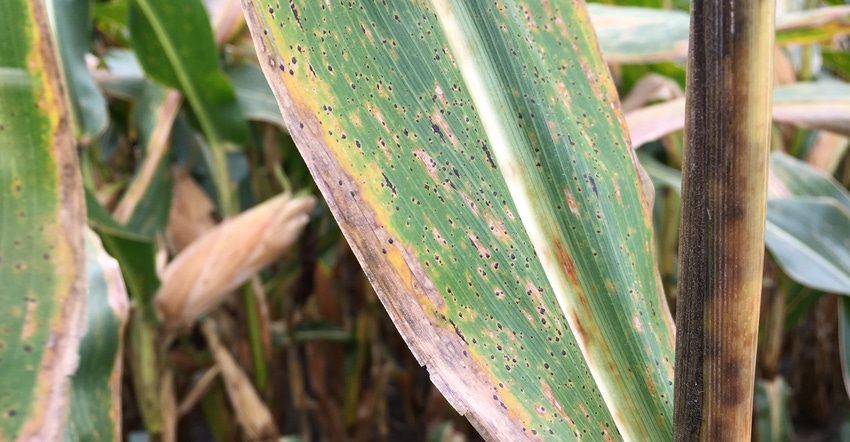
Growers in most parts of northern Illinois hit hard by tar spot in corn last season are not seeing as severe of an issue this season, according to samples fielded by the University of Illinois.
The newcomer fungus Phyllachora maydis has been in the state since 2015, but became a newsmaker in 2018, when fields in the most severely affected regions of the U.S. reached 100% disease incidence, and some fields achieved over 50% severity of the black raised spots on the ear leaf before dent. Yield losses from the affected states were estimated at nearly 185 million bushels.
2019 is a different story, with delayed and prevented planting occurring throughout much of the northern Illinois region where tar spot showed up most severely last year. Some affected counties had over 25% prevented planting acreage.
“It’s an obligate pathogen, so in order to increase its numbers, it needs living hosts, and if you don’t have as much of the host out there, you simply don’t have as much inoculum for next year. That means your likelihood of seeing a significant epidemic is going to be reduced,” says Nathan Kleczewski, U of I field crop pathologist.
Tar spot can linger on corn residue for at least a year, which is why Kleczewski says chopping and managing residue would “intuitively help at the field-scale, because the disease might otherwise be able to start earlier, and when that happens, it might become more severe and impact yield more by harvesttime.”
Aerial spread of P. maydis spores from field to field, however, makes collecting data on the effectiveness of residue management difficult to assess.
While the severity of tar spot in Illinois is less than it was in 2018, it still showed up in most of the same places. By the end of September and beginning of October, the northern Illinois region received more rain and cooler temperatures, which favor development of disease.
“When you start seeing it at R5 at low levels, it’s not going to build up much. But if you’re concerned about standability, the best thing you can do is go out there and look at your lodging potential,” Kleczewski says, noting if fields start showing lodging of 10% or greater “consider harvesting those fields first. That way you’re minimizing the chances for lodging and also perhaps saving yourself the cost of a fungicide application.”
And in northwest Illinois areas like Stark County, a few extra rains before a consistent weather pattern moved in meant tar spot started developing earlier than R5. The wet and moderate temperature conditions that eventually spread across the whole northern region brought stress and the potential to amplify yield loss with a confluence of pathogens that favor those conditions — most notably, gray leaf spot.
“I don’t think there’s anything unique about gray leaf spot or northern corn leaf blight or any of these other diseases that we saw coming in last year working together with tar spot,” Kleczewski says. “I think it’s just that those conditions are very conducive to a lot of these common foliar diseases that we have.” He says less stress will lead to less yield loss.
To prepare for next season, Kleczewski keeps a continuously updated map of where tar spot has been identified via sample submission to the U of I plant diagnostic clinic or his lab.
Kleczewski says while the industry is working on assessing and selecting for hybrids with more tolerance to tar spot for 2020, standability characteristics such as stay-green will minimize the impact of foliar infections by tar spot and other diseases, which can reduce carbohydrate stores in the stalks and roots and increase lodging potential.
“My recommendation would be if you’re in the northern part of the state, where it seems like tar spot may have more potential to become more of an annual issue, you want to select the hybrids that are more tolerant to tar spot and other foliar diseases that also have good stay-green potential,” Kleczewski says.
About the Author(s)
You May Also Like




